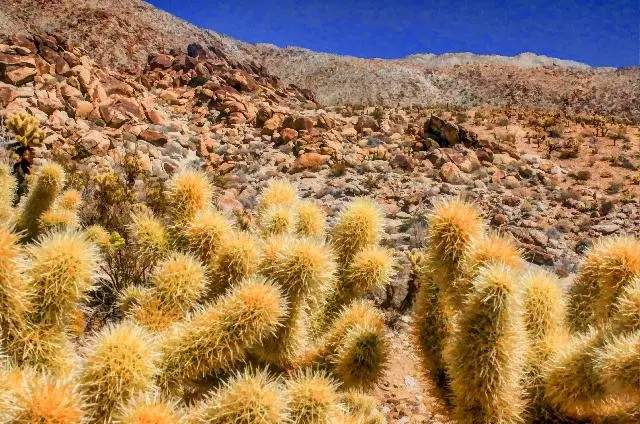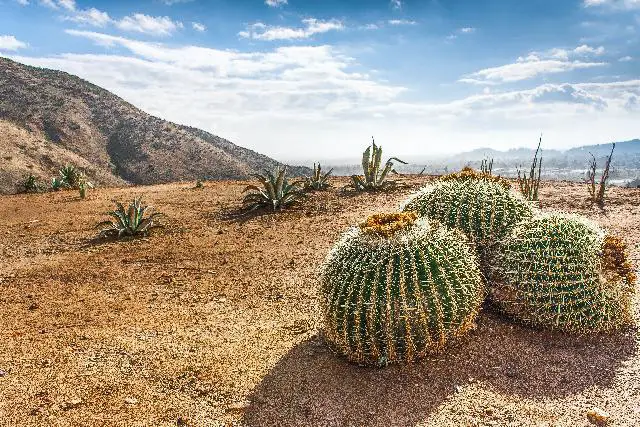Last Updated on August 16, 2023 By Emma W. Thomas
Cactus turning yellow may indicate overwatering, root rot, or inadequate drainage. About 95% of cacti need minimal watering, usually every 2-6 weeks. Assess soil moisture and adjust the watering frequency. Ensure pots have drainage holes, and consider repotting if root issues arise.
Why Is My Cactus Turning Yellow?
There are also other reasons such as insect or bug infestation, the wrong type of soil, and lack of proper nutrients. The good thing is that yellowing can be corrected with proper care for your cactus. When you notice your cactus is turning yellow, make some small adjustments to help your plant survive. Let’s look at five reasons why cacti turn yellow and how you can correct each.
- Overwatering or underwatering
- Lack of sufficient light
- Heavy soil type
- Insect and bug infestation
- Lacking adequate nutrient

1. Overwatering Or Underwatering
Even though the cactus is a desert plant, it needs water to survive and thrive. You need to water your cactus at least once per week for it to stay healthy. When a cactus plant gets enough water, it reserves some and swells. Lack of adequate water causes your plant to use up the water it has reserved, causing it to look shriveled. Your cactus also begins to turn yellow from the soil going upwards. To correct this, water your plant often. You could use a stick or your finger to check whether the plant needs more water. Insert a wooden stick, and when it comes out dry, you need to re-water your plant. Sometimes overwatering is harmful to your cactus because it prevents proper aeration. When air doesn’t get to the roots, your cactus turns yellow and might die due to bacteria. Overwatering also causes your cactus to rot from the roots. It is advisable to water your cactus according to demand but at least twice weekly.
2. Lack Of Sufficient Light
Light is essential to the growth and survival of a cactus plant. Inadequate light causes your plant to start growing towards the source of light, and some parts turn yellow. Ensure you put your plant where there is sufficient sunlight, such as a window. If your cactus is an outdoor plant, place it where it will get sufficient sunlight while preventing scorching. Sunburns on the cactus cause yellowing from the top going downwards. It is unimaginable that cactus can be scorched, yet they are dessert plants. Not all cactus thrive in bright light, and some need partial light to remain healthy. Store-bought cactus that have never grown in the desert shy away from bright light and are mostly indoor plants. When a cactus turns yellow from the top, you can easily correct it by providing partial shade to your plant.
3. Heavy Soil Type
Cactus plants are meant to grow in the desert where the soil is sandy and properly draining. When purchasing a potted cactus, always ensure you look at the type of soil used. Some florists use clay soil, which tends to retain much water. Too much water in the soil causes cactus roots to rot, thus being unable to transport nutrients from the soil. When this happens, your cactus starts to turn evenly yellow. To correct this, you can mix sandy soil into your pot and improve the soil’s drainage. If your plant is in a very big vase, it might retain more water. It would help if you made holes at the bottom of the vase to help in drainage.
4. Bug And Insect Infestation
Cactus plants are so prone to insect and bug infestation because these insects love to suck the sap out of succulent plants. When these insects attack, they leave scars and blemishes that might cause yellowing. You need to take proper care of your plant to keep the infestation from spreading. If you notice insects on your plants, get an insecticide from a pest control store. We advise against trying random insecticides as some might be harmful to your plant and the environment. You might need to consult a professional gardener in case the infestation persists.
5. Lacking Adequate Nutrients
Another reason why your cactus might be turning yellow is the lack of adequate nutrients. When a cactus cannot absorb nutrients from the roots, it becomes malnourished and changes color. This could be a result of rotting roots or harmful bacteria in the soil. Inspect the root of your plants first to see if you can salvage them. You can save your cactus by scrapping off the rotten roots and replanting them in different soil. You can also boost nutrients in your soil by adding some manure. If you are not sure of the quantities to use depending on plant size, consult a professional.

How to Save a Cactus That is Turning Yellow
1. Identify the Reason
The first step to save a cactus from turning yellow is to identify the possible reasons behind it. Overwatering, using inappropriate soil type, lack of light, or pests and diseases can all cause a cactus to turn yellow.
Common Reasons Behind Yellow Cacti
| Cause | Description |
|---|---|
| Overwatering | Too much water leads to root rot, causing the cactus to turn yellow. |
| Inappropriate Soil Type | Cacti require well-draining soil. If the soil retains too much water, it may lead to root rot. |
| Lack of Light | Cacti need plenty of sunlight. Without sufficient light, they may become pale or yellowish. |
| Pests and Diseases | Certain pests and diseases can also cause a cactus to turn yellow. |
2. Stop Overwatering
If the cactus is receiving too much water, one should immediately stop watering and allow the plant to dry out thoroughly. Let the top inch of the soil dry completely before adding more water.
3. Change the Soil
If the soil is not aiding proper drainage due to its wrong type, changing the soil becomes necessary. One must use sandy or gritty soil specially designed for desert plants; it allows enough aeration and helps in maintaining the roots’ health.
4. Move the Cactus to a Brighter Spot
In cases where lack of adequate light is causing yellowing, moving the cactus to a brightly lit spot could solve the problem. Cacti thrive in lots of sunlight and can tolerate direct sunlight for certain periods during the day.
5. Treat Pests or Diseases
If pests or diseases cause the problem, one should treat this promptly to avoid further damage. Use suitable pesticides and follow good hygiene practices while handling the plant.
6. Be Patient
Once the appropriate measures have been taken, being patient is key. A cactus can take time to recover fully from stress or damage due to various reasons. Regularly check its growth and changes in color; it can provide clues about its recovery.
Saving a cactus that is turning yellow requires careful examination of its living conditions and appropriate changes. Proper care about watering, light, soil, and defending against pests will help keep this desert beauty thriving in all its glory.
Frequently Asked Questions
1. Can A Dead Cactus Be Revived?
2. How Long Does Cactus Live?
3. Does A Cactus Have A Spiritual Meaning?
Conclusion
Plants bring life to any space, and Cactus do that best with minimum effort. When your cactus turns yellow, you need to act fast before you lose it. We hope this information helps you to restore color to your cactus and keep it healthy.
References:
https://www.gardenerreport.com/how-to-save-a-cactus-that-is-turning-yellow/
https://cuttingedgeplants.com/why-is-my-cactus-turning-yellow/
Emma is a graduate of Domestic Science or Family and Consumer Sciences (Home Economics) from the University of Wisconsin. She has 7 years of experience Working with the strategic section of BestBuy and now writing full-time for Homeeon.
From Managing the Home, Interiors, Cleaning, and Exteriors to Gardening and everything about Making A Home Liveable – is her passion and this Homeeon is the result of this.
Emma loves decorating her home with the best stuff found online. She cares about quality over anything and writes reviews about them here in Homeeon. Get in touch with her over Pinterest.
Keep reading her blogs.

